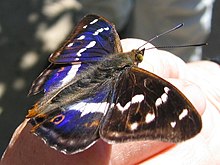Purple emperor
| Purple emperor | |
|---|---|
 |
|
| Male | |
 |
|
| Female | |
| Scientific classification | |
| Kingdom: | Animalia |
| Phylum: | Arthropoda |
| Class: | Insecta |
| Order: | Lepidoptera |
| Family: | Nymphalidae |
| Genus: | Apatura |
| Species: | A. iris |
| Binomial name | |
|
Apatura iris (Linnaeus, 1758) |
|
| Synonyms | |
|
|
Apatura iris, the purple emperor, is a Eurasian butterfly of the Nymphalidae family.
Adults have dark brown wings with white bands and spots, and a small orange ring on each of the hindwings. Males have a wingspan of 70–80 millimetres (2.8–3.1 in), and have an iridescent purple-blue sheen that the slightly larger (80–92 mm) females lack. The larvae (caterpillars) are green with white and yellow markings, and have two large "horns" at the anterior end and a smaller one at the posterior.
Dorsal side
Ventral side
Females spend most of their lives in the tree canopy, favouring dense and mature oak woodlands, coming down only to lay their eggs in the small sallow bushes that grow in clearings and rides. Males also spend much of their time in the tree tops, defending their territory from rivals, though they will sometimes descend to drink from puddles or feed. Unlike most butterflies, the purple emperor does not feed from flowers but instead on the honeydew secreted by aphids, sap oozing from oak trees, and on dung, urine and animal carcasses.
Richard South noted that collectors once used animal carcasses "in a somewhat advanced state of decay" to lure the males down to the ground, adding that this practice was "unsportsmanlike"; otherwise one needed a "high net" mounted on a pole about 14 or 15 feet (about 4.5 metres) in length to capture them. Heslop et al. noted that the males' penchant for roadkill can often cause them to be killed by cars.
They lay eggs in late summer on the upperside of sallow leaves, preferring the broad-leaved sallow, Salix caprea, but they will also use the narrow-leaved sallow, Salix atrocinerea, and various species of poplar. (Poplar is a more common food plant in continental Europe than in the British Isles.) After hatching, the larvae will lie along the midrib of the leaf where they are well camouflaged, and feed only at night. During the winter they hibernate in the forks of sallow branches, where they change colour from green to brown to match their surroundings. (The larvae are variously stated to be reach 35–40 mm long when fully fed or 55–56 mm; it is hard to give definitive measurements, given that they lack a rigid structure.) The following June they form a pale green chrysalis, 30–35 mm long and 12–15 mm in width, resembling a leaf shoot. The adults usually emerge in July, flying well into August.
...
Wikipedia
